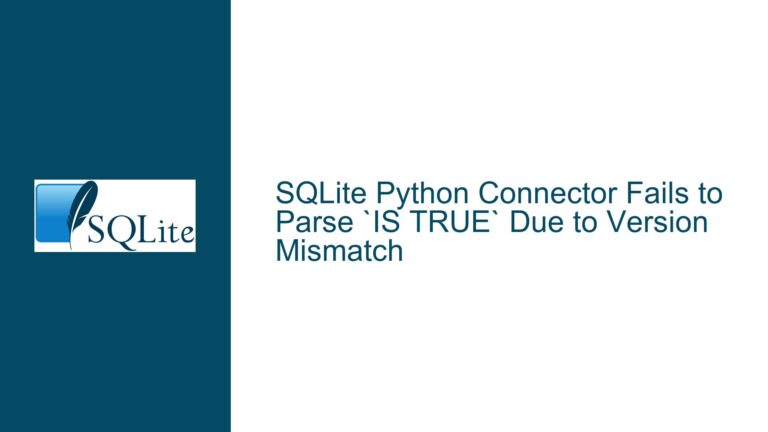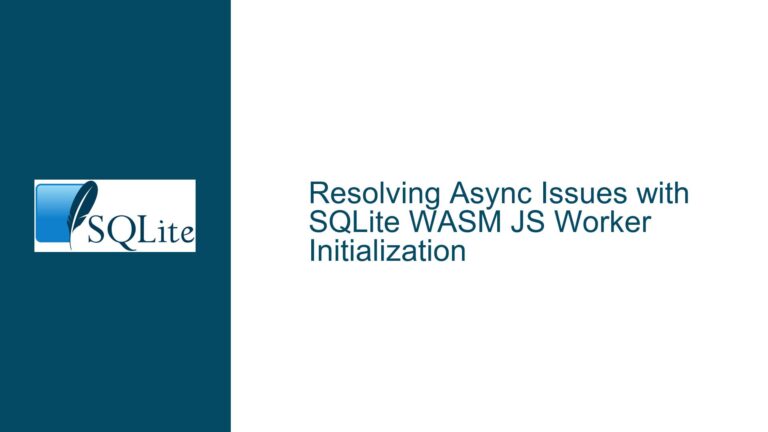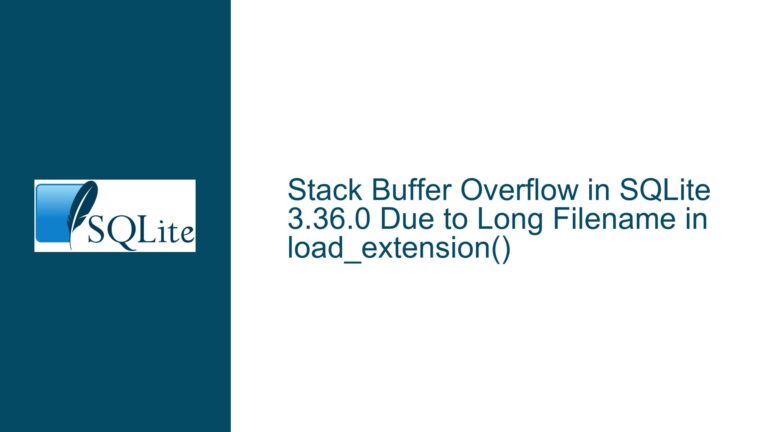Handling SQLITE_PROTOCOL Error in SQLite WAL Mode: Causes and Solutions
Understanding the SQLITE_PROTOCOL Error in WAL Mode
The SQLITE_PROTOCOL error is a rare but significant result code that can occur in SQLite, specifically when operating in Write-Ahead Logging (WAL) mode. This error arises due to a race condition in the file locking protocol, which is essential for maintaining data integrity in multi-process or multi-threaded environments. When two or more database connections attempt to start a transaction simultaneously in WAL mode, a locking mechanism ensures that only one connection can proceed at a time. The connection that loses the race backs off and retries after a short delay. However, if a single connection repeatedly loses the race over a span of several seconds, it will eventually give up and return the SQLITE_PROTOCOL error.
The SQLITE_PROTOCOL error is not a common occurrence. It typically manifests only in high-concurrency scenarios where multiple processes or threads are intensely competing to write to the same database. The error is designed to prevent indefinite waiting and to ensure that the system remains responsive. Understanding the conditions under which this error occurs is crucial for diagnosing and resolving it effectively.
The error is tied to SQLite’s internal retry mechanism. After a connection loses the locking race five times, it begins calling sqlite3OsSleep() to introduce delays between retries. Initially, these delays are minimal—around 1 microsecond—which is more akin to yielding the scheduler than an actual delay. However, as the number of retries increases, the delays grow exponentially. By the 100th retry, the delay reaches 323 milliseconds, and the total delay time before the connection gives up is less than 10 seconds. This mechanism ensures that the system does not hang indefinitely but also provides ample opportunity for the connection to succeed if the contention subsides.
Causes of SQLITE_PROTOCOL Error in High-Concurrency Scenarios
The SQLITE_PROTOCOL error is primarily caused by intense competition for database locks in WAL mode. This competition can arise from several factors, each of which contributes to the likelihood of encountering the error.
One of the primary causes is a high number of concurrent write operations. In WAL mode, write transactions require exclusive access to the database file, which is managed through a locking protocol. When multiple connections attempt to start a transaction simultaneously, they must compete for this exclusive lock. If the number of competing connections is high, the likelihood of a single connection repeatedly losing the race increases, leading to the SQLITE_PROTOCOL error.
Another contributing factor is the duration of transactions. Long-running transactions can exacerbate contention by holding locks for extended periods. This increases the chances of other connections encountering delays and retries, which can eventually result in the SQLITE_PROTOCOL error. Applications that perform complex or time-consuming operations within a single transaction are particularly susceptible to this issue.
The underlying file system and hardware can also play a role in the occurrence of the SQLITE_PROTOCOL error. Slow or overloaded storage systems can increase the time it takes to acquire and release locks, further intensifying contention. Additionally, network file systems or shared storage environments may introduce additional latency, making it more difficult for connections to acquire locks in a timely manner.
Finally, the design of the application itself can influence the likelihood of encountering the SQLITE_PROTOCOL error. Applications that do not properly manage database connections or that create an excessive number of connections may inadvertently increase contention. Similarly, applications that do not handle retries or errors gracefully may exacerbate the problem by repeatedly attempting to start transactions without addressing the underlying cause of the contention.
Resolving SQLITE_PROTOCOL Errors: Strategies and Best Practices
Resolving SQLITE_PROTOCOL errors requires a combination of proactive measures and reactive strategies. The goal is to minimize contention and ensure that the application can handle errors gracefully when they occur.
One of the most effective ways to reduce contention is to optimize the application’s use of transactions. Shorter transactions reduce the time that locks are held, thereby decreasing the likelihood of contention. Where possible, break down complex operations into smaller, more manageable transactions. This not only reduces contention but also improves overall performance by allowing other connections to proceed more quickly.
Another strategy is to limit the number of concurrent write operations. If the application allows, consider implementing a queue or throttling mechanism to control the rate at which write transactions are initiated. This can help prevent a sudden surge of contention and reduce the likelihood of encountering the SQLITE_PROTOCOL error.
Improving the performance of the underlying storage system can also mitigate contention. Ensure that the database is stored on a fast and reliable storage medium, and avoid using network file systems or shared storage environments if possible. If network storage is unavoidable, consider using a local cache or optimizing the network configuration to reduce latency.
In cases where the SQLITE_PROTOCOL error cannot be entirely avoided, it is essential to handle it gracefully in the application. Treat the error as a fatal condition and provide appropriate feedback to the user or logging mechanism. Attempting to retry the transaction immediately is unlikely to resolve the issue, as the underlying contention is likely to persist. Instead, consider implementing a backoff mechanism that introduces a delay before retrying the transaction. This can help reduce the overall contention and improve the chances of success on subsequent attempts.
For applications that require extremely high concurrency, consider alternative database solutions that are better suited to such workloads. While SQLite is an excellent choice for many applications, it is not designed for highly concurrent write-heavy scenarios. Databases like PostgreSQL or MySQL may provide better performance and scalability in these cases.
Finally, if modifying the total delay time is a requirement, be aware that this involves altering SQLite’s internal behavior. The delay mechanism is hardcoded and not configurable through standard APIs. Any changes to this behavior would require modifying the SQLite source code and recompiling the library. However, this approach is generally not recommended, as it can introduce instability and make future upgrades more difficult. Instead, focus on addressing the root causes of contention and optimizing the application’s use of the database.
By understanding the causes of the SQLITE_PROTOCOL error and implementing these strategies, developers can effectively manage contention in SQLite WAL mode and ensure that their applications remain responsive and reliable, even under high-concurrency conditions.






